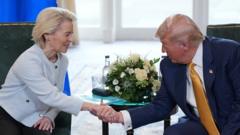In a significant breakthrough amidst ongoing trade tensions, the United States and the European Union have successfully concluded a trade deal that is poised to reshape economic relations between the two regions. Following extensive negotiations in Scotland led by President Donald Trump and European Commission President Ursula Von der Leyen, both parties agreed to impose a 15% tariff on all EU goods entering the US, a substantial reduction from the previously threatened 30%.
Trump characterized the agreement as a pivotal moment that would foster closer ties between the US and the EU, which collectively account for nearly a third of global trade. "It's going to bring us closer together," he stated, emphasizing the mutual benefits for both allies. Von der Leyen echoed this sentiment, labeling the deal as "huge" in the wake of demanding discussions.
The newly established agreement facilitates the EU's commitment to invest $600 billion in the US and to purchase substantial military equipment and energy sources, aimed at diminishing European dependence on Russian resources. In response, Von der Leyen commended Trump's leadership and negotiation skills, declaring the outcome a victory for both sides.
While they celebrate the reduction in tariffs, Trump's administration aims to sustain a 50% tariff on imported steel and aluminum. The US anticipates an influx of about $90 billion in tariff revenue based on last year's trade figures, which had shown the US importing approximately $606 billion from the EU against $370 billion in exports.
Historically, the prospect of increased tariffs had instigated fears of reciprocal strikes from the EU, targeting significant American goods such as car parts and farm products. Ministerial discussions and diplomatic engagements are ongoing, with British Prime Minister Keir Starmer also seeking to solidify relations with Trump in light of these agreements.
As President Trump continues his visit to Scotland, the successful deal marks a new chapter in US-EU relations, aiming for greater economic stability amidst shifting global trade dynamics.




















